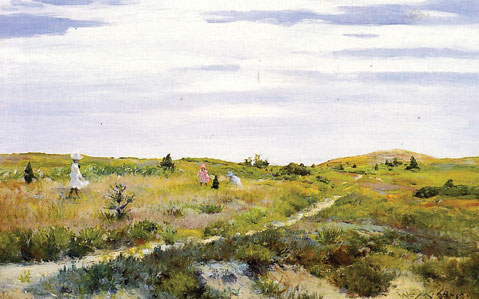Review: The Summer Impressionists, 2014 at Sullivan Goss
Show Includes Works by Winslow Homer, William Merritt Chase

Impressionism in painting is almost as easy to recognize as it is hard to define. We know the visual attributes — the emphasis on sensation, the disdain for finish, the visible brushstrokes calling our attention to the artist’s hand — but what, as a style, does impressionism mean? This excellent show offers a museum-quality introduction to impressionism’s predilections, assumptions, and underlying themes, all while celebrating the summer season and paying homage to the man who is arguably America’s most influential art teacher ever, William Merritt Chase.
The first thing to know about impressionism subject-wise is that it’s usually moving away from conventional narrative paintings of the “conversation piece” variety. Although figures may be present and engaged in identifiable activities, as in Hamilton Hamilton’s “Stroll Through a Garden” (c. 1890) or Marguerite Stuber Pearson’s “Contemplation,” there’s no receiver of the action — these women are detached and absorbed in their own worlds. Wealthy collectors seeking to stock their plush drawing rooms with beautiful objects need look no further, as these impressionist women, ostentatiously free from all practical concerns, embody the leisure their spouses confer on them. American impressionist damsels of this period — approximately 1880-1915 — have lots of free time to read letters, as in Arthur Hazard’s “The Letter” (c. 1903), or even lay in hammocks and have their novels read to them by straw-boater-wearing beaus, as in “Reading Aloud,” an 1885 work by William Verplanck Birney.
Indeed the ultimate symbol of having made it, circa 1900, was being able to afford a beach house that was far enough away from the city that during the week, only women and children are around. William Merritt Chase painted “Along the Path at Shinnecock” (c. 1902) at the height of both his powers as a painter and his success as an artist and a teacher. It shows his wife, Alice Gerson Chase, and his young children playing in the dunes along the shore in Southampton, New York, and implies the nearby presence of Chase’s recently built waterfront colonial home by famed New York architect Stanford White. Many of Chase’s best-known paintings date from this period — 1890-1905 — and portray some variation on the Shinnecock location. His large masterpiece “Idle Hours” (c. 1894), describes another scene of Alice and the kids on the same bluff, and the extraordinary “Ring Toss,” Chase’s brilliant retake of Diego Velazquez’s “Las Meninas,” was staged in the Shinnecock beach house studio. Like “Idle Hours,” “Along the Path at Shinnecock” seems designed to associate taking children to the beach on a summer afternoon with a pleasant sense of timelessness. To put it another way, there are several figures in “Along the Path at Shinnecock,” and not one of them is on it! For corroboration of this theory, look no further than Edward Potthast’s “A Timid Bather,” another of the show’s odes to summer as the season of vacation.
There’s a fascinating Winslow Homer watercolor in the middle of all this — a painting that may be more interesting for what it foreshadows than for what it discloses. “In Autumn Woods” (c. 1877) dates from the decade following Homer’s first trip abroad, which took him to Paris and exposed him to French impressionism firsthand. The figure is a peasant woman who wears a ragged apron as she clings to a tree. It’s difficult to know what is happening here other than that falling leaves animate the background. Is she shaking them loose? One thing, however, is certain: This suggestive little picture looks forward to a later moment when the artist will portray a solitary peasant woman in the foreground of another scene — the roiling whitewater of his famous late-period seascape “The Gale.” Are we heading back to the beach?



